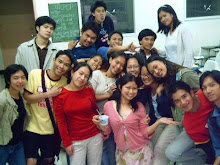My dad said my calf muscles, butoy in my native Kankana-ey tongue, are big and round camote tubers. My very objective but highly euphemistic friend told me they are the "most developed ambulating device" she has ever seen. And I see my legs as the flogging club that Fred Flintstone carries on his shoulder when he goes out to hunt for dinosaurs.
Yes, I am talking about my calves, which are distinctly muscular, same as almost every Igorot woman-be they pencil-thin or living in the lowlands, chances are their calves will give away their Igorot heritage. I had a classmate before who could have been a Ford model if her body and legs were a bit longer, but once her pants were peeled off her legs, the unmistakable bulge showed up.
The Latin anatomist termed the calf muscles gastrocnemius. The gastrocnemius contracts when one is walking or standing. For a bodybuilder whose goal in life is to flex his muscles, the developed gastrocnemius is welcomed. But for a woman who has to wear a skirt, with half her legs showing, a developed gastrocnemius is a bane, like contraband to be hidden.A well-toned body, especially the abs and glutes, is sexy, but a thick ankle and calf might be mistaken for a pine branch! This is the fate of the notorious Igorota's calves.
Nobody seems to know what to do with their calves; the Igorotas are even in a love-hate relationship with it. Some Igorotas hail their "flogging clubs" with glowing pride while others shun their "kamotes" from public eyes.
Many theories try to explain why the Igorota's calves were such. The forerunners Charles Darwin and Herbert Spencer would account it to their famous mantra "survival of the fittest, elimination of the unfit."
Living in the mountains, with its waterfalls and morning mists, looked tempting only on postcards as my Lolo vehemently agreed to. He was around at a time when men still go out into the woods to hunt for wild boars or any game and even birds, to be roasted for dinner. Women were not exempted from such physically demanding tasks of feeding the family. The women hiked for hours up to plant or harvest their fields in the next mountain from their homes. The gastrocnemius developed then, mainly, for them to survive the twisted paths, endure long hours on the trail, and run after a pig's warm flesh.
On anatomical view, the law of "use and disuse" may shed light on the not-so-mysterious Igorota's calves. Accordingly, a muscle is developed if it is used for physical activity, and may grow to accommodate the person's lifestyle. If it is not used often, it will stay the same if not sag altogether. I don't put much faith in this theory, though, when it comes to the Igorota's legs. Except for the environmental factor, women in the lowlands who can be as active physically as the Igorota still don't have bulging calves.
Young Igorotas today, although they don't have to climb mountains or endure torturous paths as their ancestors did, are still endowed with sinewy gastrocnemius. In a society obsessed with perfect body proportions, its notions reaching the traditional view of beauty, it is understandable why young Igorotas are embarrassed with their legs and forever wrap them in pants. For their ceaseless "why me?" genetics perhaps pose the answer. It is all in the genes, they say; the good ones you would want to flaunt and the bad ones to be treated as a plague. However, one can't say possessing big gastrocnemius is bad, since others see the good in it.
So far, I was not able to dig up myths surrounding the Igorota's calves. I would like to think there was once an Igorot Adam who pleaded to Kabunian to give him an Eve as brawny as he is. So Kabunian fashioned a woman, not just from lumps of clay, but also gave her arms and calves of stone before baking and breathing life into her! Or if it is a contemporary myth, perhaps Flintstone was hunting in the Cordilleras when he lost his flogging club, and here comes an Igorot man who picked it up and gave it to his wife to strengthen her legs.
The measly legend I have concocted in 10 seconds may sound silly, but I have heard others as silly. My former biochemistry instructor's theory is that Igorots eat too much potato that they were stored on their calves! (Perhaps Kabunian did not give the Igorot Eve calves made of stone but of kamotes instead?) I would have accepted her theory if not for the glaring fact that women from other ethnic groups or tribes, if they become fat or ate too much mashed potatoes or French fries, would still have slender legs and calves.
Whatever the reasons behind my bulky, ambulatory flogging device, I couldn't care less. Along with other equally-endowed women, I'd like to think of my gastrocnemius as an Igorota's trademark. It is a trademark of endurance, strength, and a great sense of adventure. Passed on to me through a chromosome strand, my butoys are the trophies of my ancestors' struggles to conquer a savage land, and later live alongside the tempers of nature.
There may be time I wish I also possess the slender and seemingly endless legs of my lowland counterpart, especially when showing off legs are necessary. But I take heart in the thought that mine is also a great asset because I have in my legs a living tradition and the history of my Igorot culture.
Now, don't I wish there were still wild boars to hunt, and a wilderness to get lost in?

















